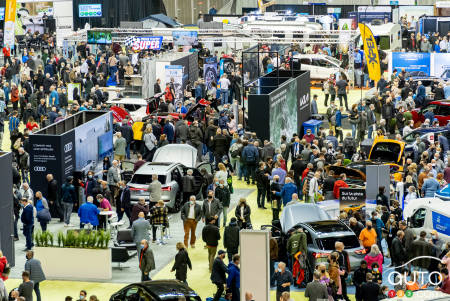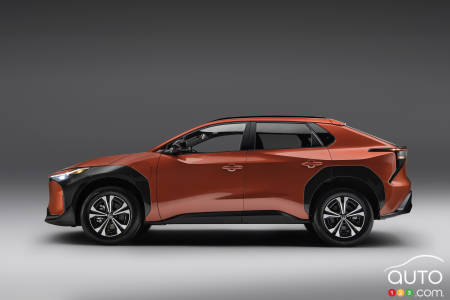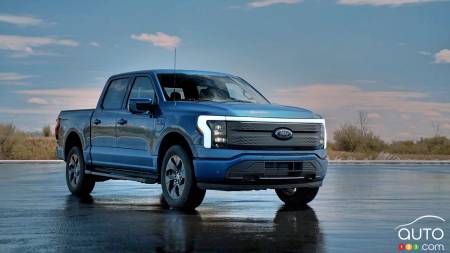Montreal has become an important hub in the electric vehicle domain, for a number of reasons, and the more than 43,000 spectators who filed into the Olympic Stadium on April 22-to-24 helped drive that point home once again. The stadium's exhibition area featured 90 exhibitors, 17 brands and a dozen models presented as Canadian premieres.
There was also a full section of electric bikes with a test track in the stadium as well as road tests of electric vehicles with the AVÉQ (Association of Electric Vehicles of Quebec). The test drives were so popular that many people had to return the next day to test drive a vehicle and all visitors were limited to one test drive to give everyone a chance.
A change in attitude in just a few months
In addition to the sheer number of visitors this year (up 75 percent from 2021), one of the most surprising phenomena we noted was the change in people's attitudes, just in the past few months. The 4th edition of the Montreal Electric Vehicle Show, remember, was held in September 2021 due to the pandemic, which forced the cancellation of the event in April 2021. We’re talking therefore of an interval of barely 7-8 months between the two events.
And yet, while the majority of the 25,000 visitors in September 2021 were looking mainly for information on electric vehicles, most of the 43,000+ visitors to the April 2022 show are already on a waiting list to acquire an electric car. One of the more common topics of conversation overheard? War stories comparing waiting times buyers were being given by auto dealers.
Browse cars for sale available near you

Many questions
One thing tied the two auto shows together: visitors’ interest and curiosity. Stationed at either the Auto Super Parts Super booth or the Connected workshop, I spent most of Saturday and Sunday answering questions about charging, range, technology and the most popular present and future electric models. The EV sector is still in its infancy and advances are happening so fast that people often wonder if now is the right time to make the switch, given that even a year can bring big developments. The answer to that is, well, complicated.
No inventory
The problem right now is the lack of vehicles. Many people told me they had put themselves on waiting lists for four or five different models from different manufacturers, with the hope that maybe one of them will come through with an actual vehicle before too long. Unfortunately, the current wait is two to three years for an electric model, except for Tesla which will take three to six months depending on the model.
Has the rising price of gasoline led to a run on electric vehicles at dealers? Certainly, this reality is contributing to this surge in popularity, and it explains the frustration felt by consumers as they’re being told to wait for an indefinite period of time.
In any case, as I've mentioned to many people, the lithium-ion battery technology that is prevalent right now will still be dominant in three or four years, so the technology likely won’t change that drastically in the near-term.

The most popular models at the show
We were treated to an wide range of electric vehicles, along with a large section of electric bikes of all kinds at the back of the exhibit centre that sat alongside car dealerships, three of which were Chevrolet dealerships that were essentially showing the same Bolt EV and Bolt EUV models.
The most popular section was the manufacturers’ section, no surprise. Ford was on hand with the new e-Transit electric commercial van and a pre-production model of the F-150 Lightning pickup. BMW made itself discrete with its kiosk sitting in back with the bikes in a small, almost invisible corner, and yet it had on display two major all-electric models, the iX SUV and the i4 sedan.
Subaru and Toyota were presenting, each under their own flags, essentially the same vehicle. On the one hand you had the Toyota bZ4X, on the other the Subaru Solterra. The models were of course developed in collaboration between the two Japanese manufacturers, which explains why they have more commonalities than differences.
See also: Subaru Solterra and Toyota bZ4X: What We Know So Far About the Close Cousins
Toyota and Subaru are brands that generate a lot of interest in Canada, so these EVs attracted crowds this weekend at the Olympic Stadium. However, the two models I saw the most interest in were the Hyundai Ioniq 5 and the Kia EV6.

We also counted among the exhibitors, Polestar, Audi, Lexus and Ingenium which arrives this year in Quebec. There were also Volvo and Polestar who presented models. We saved the best for last with GM which had taken a place of choice at the entrance. It was the most popular booth with Hyundai. Two soon-to-launch models were presented, the GMC Hummer EV and the Cadillac Lyriq.
The future is (almost) now
With the growing number of electric models that will be available on the market in the next few years, it is clear that this car show will grow, even as traditional shows struggle. By the way, for those unable to make the Montreal show, Quebec City hosts its own electric vehicle show on May 13, 14 and 15.
Beyond that, all we can hope for is a return to supply-chain normalcy soon and a reduction in waiting times to be able to really move into the electric era and not wait for it to happen for the next three years. Of course, the problem of future EV battery shortages will also have to be addressed, as pointed out this week by Rivian boss R.J. Scaringe.






